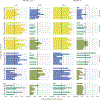"General Addiction Liability" Revisited
- PMID: 40241784
- PMCID: PMC12002852
- DOI: 10.1177/21677026241245070
"General Addiction Liability" Revisited
Abstract
Although substance use disorders are widely known to be influenced by myriad etiologic factors, recent research promotes the notion that liability toward addiction broadly construed can be described by a single, unitary dimension that we term general addiction liability. Here, we revisit the concept of general addiction liability by placing it at greater theoretical and empirical risk. To do so, we used data from two epidemiologic samples (ns from 262-8552) and employed varied quantitative methods to examine the associations between alcohol, cannabis, tobacco, and opioid use disorders. We did not find strong evidence for general addiction liability. Nevertheless, consequence-based features (e.g., social/interpersonal harm, hazardous use) tended to form cross-substance connections. We contextualize our findings in the broader literature on addiction liability and offer several explanations for why we and others arrive at competing conclusions with respect to the robustness and nature of general addiction liability.
Figures




References
-
- American Psychiatric Association, & American Psychiatric Association (Eds.). (2013). Diagnostic and statistical manual of mental disorders: DSM-5 (5th ed). American Psychiatric Association.
Grants and funding
LinkOut - more resources
Full Text Sources
Miscellaneous
